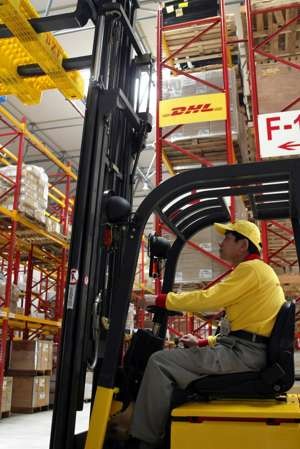
DHL adding drones and ‘copters to its courier workforce as e-commerce operation expands
Market leaders adapting fast to ever-changing customer demands, with emphasis now on faster, more convenient, internet-based delivery methods
DHL, the world’s largest logistics company, is poised for a major expansion of its delivery channels, including the wider use of shops where customers can collect parcels, drone deliveries, and what the company is calling “Parcel-copters”, says the chief executive of its rapidly growing e-commerce division.
Speaking in Hong Kong, Charles Brewer suggested the routine procedure of having a uniformed courier delivering to your doorstep is rapidly becoming less popular, simply because customers these days are less willing to sit at home and wait for arrivals.
So the company is now in the rapid process of introducing “alternative methods”, which Brewer – who’s been with the German deliveries titan since 1984 – is tipping to see the fastest growth.
“We are going to have a big, big expansion in the choice of deliveries in some places,” he told South China Morning Post on Thursday.
Courier and delivery market leaders such as DHL, UPS and FedEx are having to adapt fast to ever-changing customer demands, with the emphasis very much now on faster, more convenient, internet-based methods.

Brewer said his and other firms are increasingly facing what the industry likes to call the “parcel conundrum” – instances when shoppers enjoy the comfort and ease of picking their favourite items and placing their orders online, but are disappointed by the delivery efficiency that follows.
“Their experience quickly begins to sour as the delivery process starts to take over,” Brewer said, citing a recent DHL survey result that showed more than 80 per cent of consumers are either dissatisfied or very dissatisfied with their online delivery experience.
Many logistics firms, he added, only made deliveries to people’s homes within a time-banding, of say between 8am and 6pm, when typically people are at work.
“Nobody wants to stay at home, waiting and waiting,” Brewer added.
Brewer noted that customers are increasingly asking for what he calls “parcel lockers” and parcel shops, where they can easily collect their deliveries.
We are going to have a big, big expansion in the choice of deliveries in some places
A tie-up with intelligent locker makers will allow customers to retrieve parcels from lockers using a secure pin.
“The fastest growing delivery channel is alternative,” said Brewer, outlining the future emphasis of his e-commerce offshoot.
Since last year DHL has been running schemes in Germany to have packages actually delivered to the boots of people’s cars – in partnership with Daimler and Audi, the carmakers.
The company is also partnering with Deutsche Telekom to launch a joint research into applications of unmanned aircraft for the safe and rapid delivery of parcels in urban areas.
The first application is going to be the DHL Parcel-copter, which has been trialling since 2013.
In September, it concluded a test of shipping products including urgently needed medicines via unmanned aircraft called “Parcel-copters,” in a Bavarian village of Germany.
The planes were equipped with a mobile communications module allowing them to be located through GPS data.
“One thing that will be very popular in Asia are parcel shops,” Brewer said.
Already logistics companies such as Chinese company S.F. Express have been scrambled to join hands with bricks-and-mortar retailers such as 7-Eleven, to arrange convenient parcel pickup points.
These alternative delivery methods are still in their infancy, accounting for just six per cent of total market share, while in mature e-commerce markets such as Germany and the Nordic countries, they already represent 10 to 15 per cent, Brewer said.
“But that’s where we will end up in the rest of the world in the coming years.” he noted.

